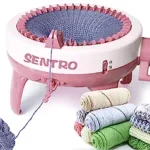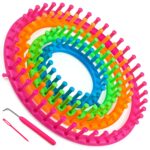How to fix a dropped stitch in knitting
Picture this: you're engrossed in your latest knitting project, steadily working row after row, when suddenly, disaster strikes—a dropped stitch! Your heart sinks as you see the errant stitch unravelling down the fabric, threatening to undo all your hard work. Fear not, as fixing a dropped stitch is a common knitting skill that every knitter should master. With a bit of patience and some simple techniques, you can swiftly recover from this knitting mishap and continue with confidence. In this comprehensive guide, we'll walk you through step-by-step instructions and helpful tips on how to fix a dropped stitch and prevent further unraveling.
What is a Dropped Stitch?
A dropped stitch occurs when one or more stitches slip off the knitting needle accidentally. This can happen if you set your work down, knit too loosely, or accidentally catch the yarn on a neighboring stitch. If left unattended, a dropped stitch can lead to laddering—a visible vertical gap in the fabric. Fixing a dropped stitch promptly is crucial to prevent further damage to your knitting project.
Spotting a Dropped Stitch
Before you can fix a dropped stitch, you need to identify it first. Look for a loose loop of yarn hanging below the row where you were knitting. The dropped stitch will look like a "ladder rung" and may be a bit tricky to spot if you're working with intricate stitch patterns or textured designs.
How to Fix a Dropped Stitch
There are several methods to fix a dropped stitch, depending on how many rows have been affected and whether you're working with knit or purl stitches. We'll cover two common methods: fixing a dropped knit stitch and fixing a dropped purl stitch.
Fixing a Dropped Knit Stitch:
1. Identify the dropped stitch: Locate the dropped stitch on your knitting needle and look below the row where the stitch dropped to find the loose yarn.
2. Use a crochet hook: Insert a crochet hook from front to back through the dropped stitch, catching the loose yarn below it.
3. Secure the stitch: Gently pull the loose yarn through the stitch with the crochet hook, pulling it up to the same level as the other stitches on the needle.
4. Return the stitch to the needle: Slip the fixed stitch back onto the left-hand needle, ensuring it faces the correct direction (the front leg should be in front).
5. Tension the yarn: Adjust the tension of the yarn by gently pulling the working yarn to eliminate any excess slack.
6. Continue knitting: Resume knitting the row, ensuring the repaired stitch blends seamlessly with the others.
Fixing a Dropped Purl Stitch:
1. Identify the dropped stitch: Locate the dropped purl stitch on your knitting needle and look below the row where the stitch dropped to find the loose yarn.
2. Use a crochet hook: Insert a crochet hook from back to front through the dropped stitch, catching the loose yarn below it.
3. Secure the stitch: Gently pull the loose yarn through the stitch with the crochet hook, pulling it up to the same level as the other stitches on the needle.
4. Return the stitch to the needle: Slip the fixed stitch back onto the left-hand needle, ensuring it faces the correct direction (the back leg should be in front).
5. Tension the yarn: Adjust the tension of the yarn by gently pulling the working yarn to eliminate any excess slack.
6. Continue knitting: Resume purling or knitting the row, making sure the repaired stitch blends seamlessly with the others.
Preventing Laddering
When fixing a dropped stitch, you might encounter a small gap or "ladder" next to the fixed stitch. To avoid laddering, you can use a simple trick called "tinking," which involves undoing stitches one by one back to the dropped stitch and then fixing it. This method prevents the ladder from forming, but it can be time-consuming, especially if the drop occurred several rows below.
Fixing Dropped Stitches Several Rows Below
If you've discovered a dropped stitch several rows below your current work, fear not! It's still possible to fix it without unraveling your entire project. This method, called "laddering down," involves using a crochet hook to bring the dropped stitch back up to the correct row.
Step-by-step instructions for laddering down:
- Insert a crochet hook through the dropped stitch from front to back.
- Gently pull the loose yarn through the stitch with the crochet hook, bringing it up to the same level as the other stitches on the row above.
- Slip the fixed stitch back onto the left-hand needle, ensuring it faces the correct direction.
- Repeat these steps for each dropped stitch until you've reached the desired row.
- Carefully knit or purl across the row to secure the repaired stitches.
Conclusion
Fixing a dropped stitch is a valuable skill that every knitter should have in their arsenal. With the techniques and tips outlined in this guide, you can confidently rescue your knitting projects from potential unraveling disasters. Remember that mistakes happen to even the most experienced knitters, and fixing them is all part of the creative journey. So the next time a dropped stitch tries to derail your knitting progress, take a deep breath, reach for your crochet hook, and confidently repair the stitch. Happy knitting, and may your knitting adventures be smooth and stitch-perfect!
To find out more about knitting, please visit any of the following areas:
- How to sew together knitting
- What is brioche knitting
- How to join yarn in knitting
- How to join in the round knitting
- How to finish a knitting scarf
- How to make a slip knot for knitting
- How to switch colors knitting
- How to hold yarn when knitting
- What does kfb mean in knitting
- How to fix a dropped stitch in knitting
- How to hold knitting needles
- What is frogging in knitting?
- How to change colors in knitting
- How to count rows in knitting
- How to increase in knitting
- How to slip stitch knitting
- How to yarn over in knitting
- What is a knitting loom?
- How to make bobbles in knitting?
- Where can I buy sentro knitting machine?
- What can you make with a sentro knitting machine?
- Cricut Hat Press: A Comprehensive Guide on Usage - August 13, 2023
- Unlocking Creativity with the Cricut Joy: A Comprehensive Guide - August 12, 2023
- The Ultimate Guide to the Cricut Maker Bundle - August 11, 2023





